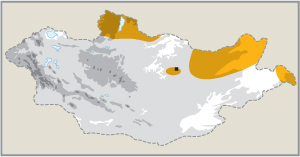
PLATE 77: LEAF WARBLERS I
Dusky Warbler Phylloscopus fuscatus
10.5–12 cm

ID A distinctly dull brown Phylloscopus with buffy underparts, closest in appearance to much rarer Radde’s Warbler, which see for distinctions. Siberian Chiffchaff differs in grey-brown plumage lacking green tinge on wings and tail; less distinct supercillium and eye-stripe; black (vs. reddish-brown) legs; habitat; and behaviour. Voice Song is a simple, repeating short phrase, e.g. chewee chewee chewee chewee, varying in tone. Call is a distinctive low, abrupt chek. Habitat Breeds in mountain taiga scrub and willow thickets near bogs and other wetlands. Seeks shrubby cover elsewhere in steppe and desert, parks and gardens on migration. Behaviour Usually forages low in undergrowth; flicks wings and tail often. Rather shy and skulking, though readily called out. Status Fairly common breeding visitor across all northern mountain ranges from Great Lakes Depression to Dornod, and common passage migrant throughout, mid-April to mid-September.
Sulphur-bellied Warbler Phylloscopus griseolus
11 cm

ID Readily distinguished from other brownish Phylloscopus by combination of long yellowish (‘sulphury’) supercilium (colour most vivid in front of eye); distinct dull yellow wash on lower breast and belly; and mostly yellow bill. See also habitat and distribution. Voice Song is a simple series of about six high tsee-tsee-tsee… notes, sometimes starting with flat, lip-smacking note and rising towards the end. Call is a soft quip or pick. Habitat Breeds on dry rocky slopes with scattered juniper, Caragana or other shrubs at high altitude (2,600–4,000 m). Uses other, mainly brushy habitats at lower altitudes on migration. Behaviour Forages mainly on or close to ground, gleaning insects from vegetation. Status Fairly rare and local breeding visitor in alpine zone of mountains in Great Lakes Depression, and Mongol-Altai, Gobi-Altai and Hövsgöl ranges. Rare passage migrant within its breeding range and in far east, late April to late August (early September in the Gobi).
Yellow-streaked Warbler Phylloscopus armandii
12 cm

ID Very similar to Radde’s Warbler, but with slightly more delicate build, somewhat finer bill, and thinner legs. Voice Song is similar to Radde’s, but ‘weaker’. Call is a sharp, bunting-like tzic, but also a tack call similar to that of Dusky Warbler. Habitat Breeds in montane willow and poplar groves and tall thickets as well as spruce stands at 1,400–3,500 m in NE and C China. Forages in other types of woody vegetation on migration. Behaviour Shy while nesting, foraging in low, dense vegetation. Status Vagrant. Two records: two singing males reported from Yolyn Am, Gurvansaikan range, Ömnögobi province, 13 June 2000; and one captured in mixed forest with willow, poplar, larch and fruit trees in Khalkh River valley, Dornod province, 25 August 2010.
Radde’s Warbler Phylloscopus schwarzi
11.5–12.5 cm

ID Similar to Dusky Warbler in overall brown and buff coloration, but differs by chunkier build; notably shorter, stouter bill; broader supercillium that is palest at rear and more diffuse in front (vs. the opposite in Dusky); distinctly pale and rather thick legs; and orange-buff (vs. uniform pale buff) undertail. Compare also Yellow-streaked Warbler. Voice Song is a series of rich, emphatic, sometimes bubbly phrases. Call is a low chrep, softer and ‘looser’ than Dusky. Habitat Typically forages in shrubby vegetation or low in small trees, but to be looked for in any wooded or brushy habitats in company of other warblers in migration. Behaviour Keeps to cover, but more sluggish in movements than Dusky and other Phylloscopus warblers. Status Rare passage migrant in northern and eastern Mongolia, late April to mid-September.